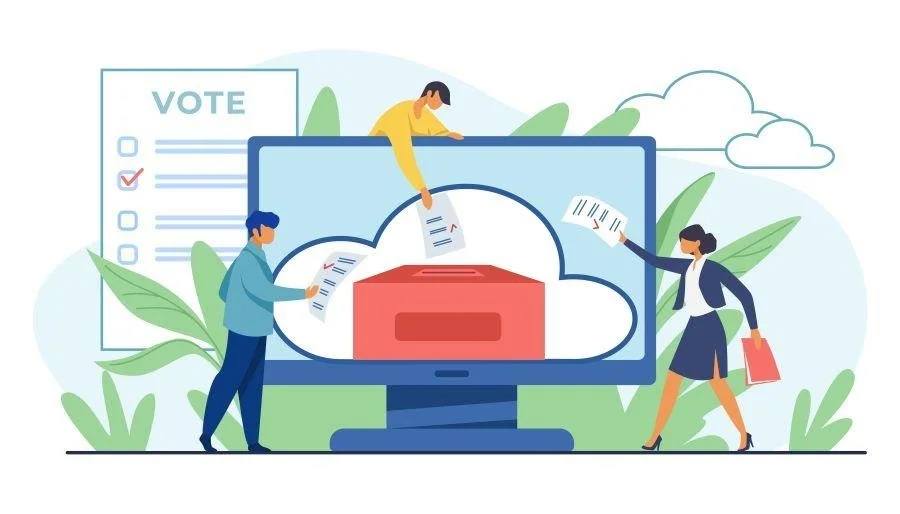The first online voting system in India 24
Online Voting System In India
The government introduced the first online voting system in India, powered by the metaverse, at MBD Neopolis Mall on Ferozepur Road, a ground-breaking effort to increase voter awareness and engagement. This ground-breaking Saturday event represented a major advancement in the democratic process’s incorporation of cutting-edge technology. The inhabitants were given the opportunity to become acquainted with the voting procedure in a futuristic environment through an immersive and interactive virtual polling booth experience.

This program seeks to dispel confusion surrounding the voting process and promote increased voter turnout for future elections.
Apart from the virtual booth, there was a live band and several other interesting activities to draw a broad audience and create a joyful environment at the event. All of these components worked together to make the event both enjoyable and instructive, emphasizing the significance of voting in a contemporary and easy-to-access way.
The administration’s dedication to utilizing cutting-edge approaches to improve civic engagement is demonstrated by the use of metaverse technology. The organizers made sure the event would have high visibility and accessibility by holding it in a well-known mall, which encouraged shoppers and bystanders to attend and learn. This innovative method raises the bar for voter education and shows how technology might change India’s political traditions.
Follow our Digiknowledge.co.in page for the latest updates about technology, bikes, cars, sports, lifestyle, and many more.
What is an online voting system?
Voters can cast their ballots online through a digital network called an online voting system. In place of traditional in-person voting at polling places, this system can be accessible via laptops, smartphones, or other internet-enabled devices. It is particularly handy.
In order to guarantee accessibility, security, and vote integrity, an online voting system in India would be built to expedite and secure the electoral procedure.
What a system like this would do is broken down below in detail:
Initial user registration and authentication:
Voters must register with the Indian Electoral Roll prior to utilizing the internet voting system. An extra registration procedure would be required for users who are new to the online system. The online voting platform would require voters to register with their voter ID number, residence, date of birth, and working cellphone number, among other personal information.
Two-Factor Verification:
Two-factor authentication (2FA) would be used to improve security. This can include:
1. A special password that the voter came up with.
2 Voters will receive an OTP (one-time password) at their registered email address or mobile number.
If possible, provide an extra layer of security with biometric verification (facial recognition or fingerprint verification).
Entering the Secure Access Portal:
Through a safe website or mobile application, voters would gain access to the online voting platform. Voters would access the portal, input their credentials (password and voter ID), and finish the 2FA procedure.
Conferencing Security:
To encrypt data sent between the user’s device and the server, the system would make use of secure protocols like HTTPS. In order to guard against unwanted access, a secure session token would be created for each session.
Utilizing an intuitive interface to cast a vote
An easy-to-use interface with concise instructions would be provided by the portal.Candidates and parties relevant to their constituency would be listed for voters to peruse.The appropriate questions and alternatives for referendums and other voting forms would be shown by the system.
Selection of votes:
By clicking or tapping on the candidate or option of their choice, voters would make their selection.Voters would be able to evaluate their selections prior to final submission thanks to the system.
Verification of votes:
The system would show a confirmation screen outlining the voter’s selections prior to the final submission. Voters would be given the choice to amend or confirm again.
Encryption: A measure of security and integrity
Sophisticated encryption methods would be used to protect all data, including voter credentials and votes.From the time of casting until the point of storage in the digital ballot box, end-to-end encryption would guarantee that votes stay private.
Blockchain:
Blockchain technology might be applied to provide tamper-proof records and transparency. Votes would be easily verifiable and immutable since they would be recorded as blocks in a blockchain.
Trails of audits:
Ensuring voter confidentiality would not be compromised, as the technology would preserve an audit trail of every transaction.
To confirm the fairness of the election process, anonymized data would be made available to independent auditors.
Propriety and Non-Identification:
In order to prevent voter identity from being linked to specific votes, votes would be anonymized as soon as they were submitted.
Just total vote counts would be available for tallying, thanks to the system’s safeguards.
The Post-Voting Procedure
The votes would be decrypted and totaled after the voting session is over.
Total Voting:
The correctness of the tallying procedure would be guaranteed by blockchain technology and other verification techniques.
Statement of Results:
The results of the election would be made public following extensive auditing and verification.To view the status of their vote (such as whether it has been counted), voters could log onto the system
Responses and Assistance:
If voters run into any problems during the voting process, a special support system will be on hand to help. In response to voter experiences and technical developments, feedback mechanisms will be implemented to continuously enhance the system.
To make sure an online voting system is implemented successfully in India, careful planning and strong security measures are needed. Through the use of cutting-edge technology like biometrics, blockchain, and encryption, the system would give Indian residents a safe, convenient, and effective means to take part in the political process. This might lead to an increase in voter turnout and guarantee that every vote is counted.
What are the benefits of implementing an online voting system in India?
Increased voter participation is one of the advantages of introducing an online voting system in India, particularly for individuals who find it difficult to travel to polling places, such as the elderly, the crippled, or foreign residents. It can also lessen the likelihood of election-related violence and fraud. It also saves time and money when it comes to setting up and running actual polling places.
What are the challenges facing the adoption of online voting in India?
Ensuring strong cybersecurity to stop hacking and data breaches, protecting voter privacy and anonymity, and guaranteeing that every voter has equal access to the required technology and internet connectivity are among the issues. Concerns exist regarding the general public’s digital literacy as well, particularly in rural areas.
What role can the government play in promoting online voting?
The government can support online voting by funding the required infrastructure, guaranteeing strong cybersecurity protections, launching public awareness campaigns about the advantages and security of online voting, and introducing pilot programs gradually to hone the system and foster confidence.





I don’t see how you aren’t even more well-liked than you might be right now. Your breadth of knowledge on the issue convinced me of your extraordinary intelligence from a number of angles. It appears that until something has to do with Lady Gaga, people are uninterested in everything. Continue your fantastic work.
Thank you for your kind words! I’m glad to hear you find the recent posts engaging and valuable. Your feedback is much appreciated, and I’m happy to be added back to your daily blog list. If there’s anything specific you’d like to see more of or any topics you’re particularly interested in, feel free to let me know. I’m here to help!
Pingback: Great Nikobar Project:Transforming an Island Paradise 24
Thank you for your kind words! I’m glad to hear that you find the content interesting. If you have any specific topics or questions you’d like me to cover in future posts, feel free to let me know. Happy reading!
rt